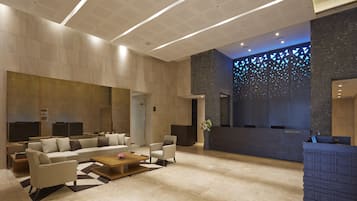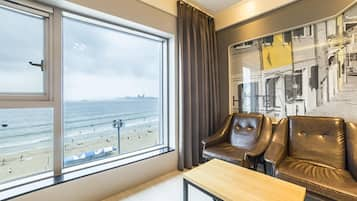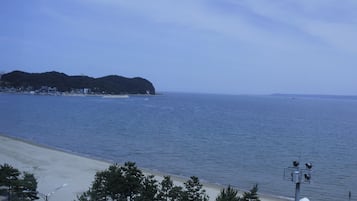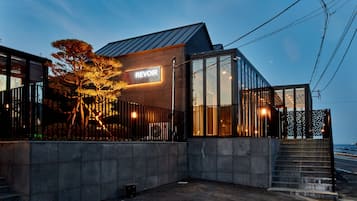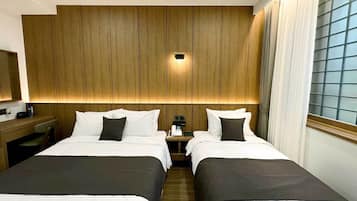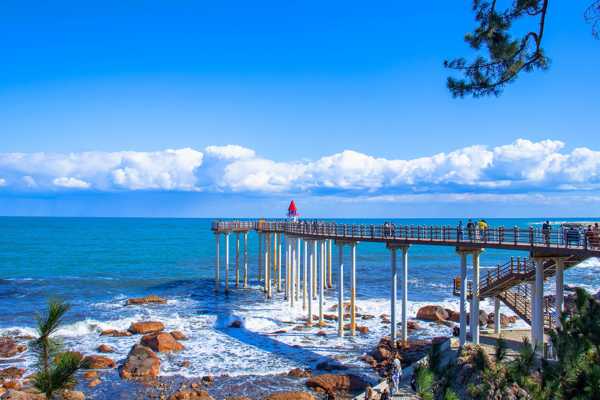The northern part of Pohang forms the southern end of the Taebaek Mountain Range, and has a high and rugged terrain with many lofty mountains. Thanks to its unique natural environment, it is a perfect destination for those who want to feel the charm of nature. Naeyeonsan Mountain, where Bogyeongsa Temple with a history of more than 1,000 years is located, and Sibipokpo Falls, one of the top three scenic spots of Gyeongsangbuk-do, present a superb view of waterfalls and lush forests. Juwangsan Mountain, the nation's 12th national park, is a rocky mountain made up of tuff that was formed by the consolidation of lava some 70 million years ago, and is a UNESCO Global Geopark. As a famous mountain that has witnessed the 1,000-year history of the Silla Dynasty, it features many attractions around the Juwang Valley.
Also, visit the Gyeongsangbuk-do Arboretum at the foot of Unjesan Mountain and Keychungsan Botanical Garden in the city centre to see a variety of native wildflowers and plants harmonized with the natural landscape. Jungmyeong Eco Park and the Cheonmaji Trail are popular destinations for family outings. The Seonbawi-gil Trail, one of the coastal trails at Homigot Cape, is a walking path where you can appreciate the view of the sea and rocks in different shapes while listening to the sound of the waves. The Blue Road, which starts from Yeongdeok Snow Crab Park, covers the 19th and 22nd courses of the Haeparang Trail on the eastern coast, where you can hike having fun while discovering the stories of each coastal village located where the forest and the sea meet. Check out the natural attractions of Pohang that boasts beautiful scenery created over time!
- 1
Naeyeonsan Mountain
Home to a thousand-year-old temple and Sibipokpo Falls

- Οικονομική διαμονή
- Οικογένειες
- Ιστορία
- Φωτογραφία
Naeyeonsan Mountain is one of the three scenic spots in Gyeongsangbuk-do, and has been also selected as one of the 100 most famous mountains by the Korea Forest Service. Bogyeongsa Temple, a thousand-year-old Buddhist temple, and Sibipokpo Falls that changes scenery for each season, make the mountain a four-season recreational destination favoured by tourists and hikers. It is said that Bogyeongsa Temple was established on the site where the octagonal mirror, a Buddhist treasure, brought from India by Master Jimyeong was buried during the Silla Dynasty. After parking your car in the free carpark and enter the precincts of the temple, you will be greeted by a pine tree stretching up to the sky in the shape of a dragon ascending to heaven and a 400-year-old hardy-orange tree.
There are various hiking trails including a trekking trail that passes through the precincts of Bogyeongsa Temple and stretches along the Gapcheon Valley, and another trail that leads to the mountaintop. If you choose the trail leading to Yeonsan Falls, which is the 7th waterfall of Sibipokpo Falls, you can enjoy a leisurely walk, covering 5 km for a round trip. Around Yeonsan Falls, you can see a pond with a depth of several tens of metres, caves, and rocks in different shapes that altogether create picturesque scenery. The nearby Sogeumgang Observatory commands a three-dimensional view of the surrounding natural wonders. You can also admire the scenery of the river meandering along the valley from Seonildae, a precipitous rock cliff from across the waterfall.
Τοποθεσία: 922, Jungsan-ri, Songna-myeon, Buk-gu, Pohang-si, Gyeongsangbuk-do, South Korea
Τηλέφωνο: +82 (0)54-240-7555
Χάρτης - 2
Juwangsan National Park
A famous mountain where countless stories are hidden in the valley

- Οικονομική διαμονή
- Οικογένειες
- Ιστορία
- Φωτογραφία
Juwangsan National Park has been designated as the 12th national park of Korea, and Juwangsan is the most celebrated mountain in the Yeongnam region and one of the three major rocky mountains in Korea along with Seoraksan Mountain and Wolchulsan Mountain. It is also an excellent geological field trip destination, as the mountain is made up of welded tuff formed by the consolidation of volcanic lava some 70 million years ago and preserves the traces of the volcanic activity that occurred on the Korean Peninsula throughout the geological periods. A total of 24 geosites in the park including Giam Cliff, Yongchu Gorge, Columnar Joints, and Jusanji Reservoir have been certified by the UNESCO Global Geopark programme.
Juwanggyegok Valley, which meanders through the mountain hills, has many attractions such as Haksodae Cliff said to have been inhabited by blue and white cranes, Geupsudae Cliff that soars to the sky as if it was about to fall, and Juwanggul Cave featured in a legend of Zhou Du from the Eastern Jin Dynasty of China, who hid himself in this cave escaping the Tang Army. Also, wild azaleas in spring and maple leaves in autumn catch the eye of visitors. Visit Daejeonsa Temple built 1,300 years ago during the reign of King Munmu of Silla, and Baengnyeonam, named after Princess Baengnyeon, who is believed to be the daughter of Zhou Du. When the weather is nice, climb atop Gamebong Peak that commands views of the coastal waters of Yeongdeok in the distance, and appreciate the sea of clouds spreading across the vast mountain ridge. The hiking course leading to Gamebong Peak is hard to finish, so it is worth giving it a try.
Τοποθεσία: Sangui-ri, Budong-myeon, Cheongsong-gun, Gyeongsangbuk-do, South Korea
Ώρες λειτουργίας: 24/7
Τηλέφωνο: +82 (0)54-870-5341
Χάρτης - 3
Gyeongsangbuk-do Arboretum
Arboretum located where the mountain and the sky meet

- Οικονομική διαμονή
- Οικογένειες
The Gyeongsangbuk-do Arboretum is the largest arboretum in Korea located at an altitude of 650 metres above sea level. Collecting and preserving trees and plants distributed in Gyeongsangbuk-do and conducting research on the use of these natural resources, the arboretum provides visitors with the opportunity to relax their body and mind and experience nature. It consists of 26 themed gardens including the Alpine Botanical Garden, Ulleungdo Botanical Garden, and Coniferous Garden. In particular, the Ulleungdo Botanical Garden exhibits rare species endemic to Ulleungdo Island and Dokdo Island featuring unique ecological characteristics, including the beech and Ulleungdo cotoneaster.
Take a tour of this large arboretum while enjoying a leisurely stroll and resting in the many rest areas found throughout. After passing the Mugunghwa Garden, a small pond called Sammidam can be seen. Take a break at the small pavilion next to the pond and admire the colourful water lilies and the 1/110-scaled model of Dokdo Island floating on the pond. You can learn about the forest and nature in experiential zones such as the Forest Commentary and Exhibition Hall, Forest Experience and Learning Center, and Forest Ecology Observation Trail. Book a popular tailored forest commentary programme to take a guided tour by a professional forest commentator and participate in various experiential programmes.
Τοποθεσία: 647, Sumogwon-ro, Jukjang-myeon, Buk-gu, Pohang-si, Gyeongsangbuk-do, South Korea
Ώρες λειτουργίας: March–October: daily from 10 am to 5 pm. November–February: daily from 9 am to 4 pm
Τηλέφωνο: +82 (0)54-260-6100
Χάρτης - 4
Blue Road
Walking trail designed for natural exploration

- Οικονομική διαμονή
- Οικογένειες
- Φωτογραφία
The Blue Road is a 64.6 km coastal walking trail that starts from Yeongdeok Snow Crab Park and stretches through Chuksan Port to Goraebul Beach. It is divided into 4 sections, and also forms the 19th to 22nd sections of the Haeparang-gil Trail, a long walking trekking trail on the east coast connecting Busan and Goseong. The Blue Road consists of forest and marine sections that alternate repeatedly, so you can enjoy trekking without getting bored.
Starting with Course D that begins at Snow Crab Park, take Courses A, B, and C in turn and experience countless attractions and foods that represent each course. Each course has been given a name that represents their characteristics, including Indigo Wave Promenade, Light and Wind Promenade, Blue Snow Crab Promenade, and Mogeun Promenade of Contemplation. Walk following the yellow arrow-shaped signs and receive stamps at each section to receive a medal. If walking all sections of the trail feels burdensome for you, you can combine walking and driving to enjoy your trek, searching for various healing spots.
Τοποθεσία: 307-6, Bugyeong-ri, Namjeong-myeon, Yeongdeok-gun, Gyeongsangbuk-do, South Korea
Τηλέφωνο: +82 (0)54-730-6514
Χάρτης - 5
Seonbau Trail
Appreciate the natural landforms around the coast

- Οικονομική διαμονή
- Οικογένειες
- Φωτογραφία
The Seonbau Trail covers the 2nd course among the 4 courses on the 25-km Homi Peninsula Coastal Trail, which is known for its beautiful coastal scenery. As a 6.5-km section from Ibam-ri, Donghae-myeon through Heunghwan Beach to Heunghwan Fishing Port, the trail consists of deck roads stretching along the coast with rocks in different shapes, allowing visitors to appreciate the seascape while listening to the sound of the waves.
The Seonbau Trail, which starts in a peaceful fishing village, presents spectacular coastal scenery from the milestone indicating the beginning of the road. Seonbawi Rock standing at the entrance of the deck is said to have been reduced in size after being struck by lightning, but it still captures the eyes of passers-by. As you walk along the trail, you will come across rock after rock each with different names. Starting from Pokpobawi Rock that turns into a waterfall when it rains, you will pass Sonbadak Rock resembling the palm of independence activist Ahn Jung-geun, the cute Gorilla Rock, and Hindigi Hill with many white rocks, until you reach Haseondae Cliff believed to be a place where seven Taoist fairies danced and sang. Meokbawi Rock where the legend of Yeonorang who was crowned as king in Japan and his wife Seonyeo was born is also one of the attractions you can find walking along the trail.
Τοποθεσία: 41, Homi-ro 2790beon-gil, Donghae-myeon, Nam-gu, Pohang-si, Gyeongsangbuk-do, South Korea
Ώρες λειτουργίας: 24/7
Χάρτης - 6
The Twelve Falls of Naeyeonsan Mountain
Valley lined with 12 waterfalls

- Οικογένειες
- Φωτογραφία
Gapcheongyegok Valley on Naeyeonsan Mountain, which has a length of 14 km, features 12 waterfalls where natural forests, rocks, and columnar joints harmonize perfectly. It is rare in the world that a single valley has so many waterfalls. The rocks here are tuffs made of hardened volcanic ash, and the waterfalls were formed as the rocks were broken and eroded by water flowing along the crevices in multiple directions. The plunge pools created by the erosion of water falling down the waterfalls, and the caves behind the waterfalls were created as weak, soft rocks eroded over a long period of time.
The first waterfall that you come face to face with is Sangsaeng Falls, followed by Bohyeon Falls, Sambo Falls, Jamnyong Falls, and Mupung Falls. Each of these waterfalls has its own stories. The 6th waterfall, Gwaneum Falls, has been regarded the most scenic of the 12 waterfalls, so it has been dubbed “Sogeumgang” (Small Geumgang) since ancient times. Take a look around Gamrodam Pond formed by water cascading down the waterfall and Gwaneumgul Cave located behind the waterfall. Cross the suspension bridge over Gwaneum Falls, pass Yeonsan Falls, the largest of the 12 waterfalls, and climb to the top of Seonildae Cliff to admire the scenery. You will find Samyongchu Falls, a 3-storey waterfall that was once painted by Gyeomjae Jeong Seon, the master of jingyeong sansuhwa (real scenery landscape) painting in the late Joseon Dynasty.
Τοποθεσία: 622, Jungsan-ri, Songna-myeon, Buk-gu, Pohang-si, Gyeongsangbuk-do, South Korea
Ώρες λειτουργίας: 24/7
Τηλέφωνο: +82 (0)54-262-1117
Χάρτηςφωτογραφία από Garry Burns (CC BY-SA 2.0) τροποποιήθηκε
- 7
Cheongsong Eoreumgol Valley
Amazing natural phenomenon and magnificent scenery
- Οικονομική διαμονή
- Οικογένειες
- Φωτογραφία
Cheongsong Eoreumgol Valley is famous for an unusual natural phenomenon occurring in summer, where ice forms on the stones when the temperature rises over 32 degrees Celsius, and then melts when the temperature falls below 32 degrees Celsius. It is a popular spot with vacationers who want to cool off in the superb scenery of artificial waterfalls and oddly-shaped rocks in summer and rock climbing and mountaineering enthusiasts who enjoy climbing the 62 metres ice wall created by the artificial waterfalls in winter.
Start your trip to the Eoreumgol Valley during the summer season at the Eoreumgol Valley Area Revitalization Centre. You can also participate in the experiential program to make delicious scones with apples grown in Cheongsong. In the nearby Cheongsong Climbing Academy, you can experience outdoor rock climbing. The facility also provides neat accommodations that you can use at reasonable prices. Have fun in the valley water, taste cool spring water, and admire the artificial waterfall of Tanggeonbong Peak. The Eoreumgol Valley is a popular destination not only for summer vacations but also for winter holidays. The superb view around the ice wall and valley that resemble the ice castle featured in the animated film “Frozen” attracts many couples who want to take pretty photos together.
Τοποθεσία: 228, Palgaksan-ro, Juwangsan-myeon, Cheongsong-gun, Gyeongsangbuk-do, South Korea
Ώρες λειτουργίας: 24/7
Τηλέφωνο: +82 (0)54-873-0101
Χάρτης - 8
Jungmyeong Eco Park
Enjoy nature to the fullest in the city centre
- Οικονομική διαμονή
- Οικογένειες
Jungmyeong Eco Park is an ecological park created along a 1 km path in the valley at the foot of Unjesan Mountain. The trail is decorated with various trees including golden rain trees, which are endemic to Korea, and wildflowers under different themes. The park is equipped with various eco-learning facilities such as the Wildflower Garden, Medicinal Herb Garden, Small Animal Garden, and Rock Garden, and in the vicinity of the park are a variety of attractions such as the Ongnyeobong Observatory, rest area, and lawn plaza. As the park is located close to the city centre, many family picnickers visit with their children. There are also many sculptures of animated film characters catering to children. In addition, interesting descriptions provided on the labels of each tree and flower arouse the curiosity of nature in children.
After looking around the park, head over to the hiking trail to the ridge of Ongnyeobong Peak, where you can see the 18-metre-high UFO-shaped Ongnyeobong Observation Tower. From the observatory, which is officially named “Bitnuri Eco Tower,” appreciate the view of the city of Pohang, Homigot Cape, and the beautiful East Sea. Don't forget to stop by Jade 826, a gallery café close to the Ecological Park, and have a cup of coffee while viewing an exhibition.
Τοποθεσία: 1152, Jungmyeong-ri, Yeonil-eup, Nam-gu, Pohang-si, Gyeongsangbuk-do, South Korea
Ώρες λειτουργίας: 24/7
Τηλέφωνο: +82 (0)54-270-6586
Χάρτης - 9
Keychungsan Botanical Garden
Forest experience based on the philosophy of naturalism
- Οικογένειες
- Φωτογραφία
Keychungsan Botanical Garden is a private botanical garden with a 40-year history located in Cheongha, a green area of Pohang. It is operated with the aim of contributing to promoting the Korean lifestyle that most seeks the harmonious coexistence of nature and humanity. The name “Keychungsan” is a combination of two Korean words meaning a winnow (“ki”) used to separate grains and chaff and a Korean utopia (“Cheongsan”), which reveals the founder's aspiration. It is a museum-style botanical garden where visitors can learn about the knowledge of plants that has accumulated over a long period of time, unlike a typical park-style botanical garden that you can just look around.
There are many stories hidden in every corner of the garden that forest commentators tell you about through a tour along the trail featuring 2,500 species of endemic wildflowers, trees, and exotic plants. Among the 15 exhibition gardens, the Endemic Flower Garden, Ulleung Botanical Garden, Mugunghwa Flower Garden and Yongyeonji Pond are not to be missed visiting. In addition, the garden operates various experiential programs, including a forest experience, archery experience, and various handicraft making courses. There are also environmental education programs catering to teenagers. The training course is designed for next-generation talented individuals and those majoring in related fields, so it is worth taking if you want to professionally engage in environmental activities.
Τοποθεσία: 57, Cheongha-ro 175beon-gil, Cheongha-myeon, Buk-gu, Pohang-si, Gyeongsangbuk-do, South Korea
Ώρες λειτουργίας: Tuesday–Sunday from 9 am to 6 pm (closed on Mondays)
Χάρτης - 10
Cheonmaji Trail
Discover Lake Baikal in Pohang full of the fragrance of azaleas and pines
- Οικονομική διαμονή
- Οικογένειες
- Φωτογραφία
The Cheonmaji Trail was created to encircle Cheonmaji, a valley-type artificial reservoir. Cheonmaji is a reservoir that stores agricultural water, but boasts a beautiful landscape like a natural lake in the mountains. Since most of the trail has no slope, you can take a leisurely stroll following a 2.8 km course that takes around 1-2 hours to complete.
If you start walking past Daegaksa Temple at the entrance to the trail, azaleas and pine trees welcome you. The fragrance of azaleas and pine trees will refresh your body and soul as you walk along the trail. Go up to the observatory that commands a panoramic view of Cheonmasan Mountain and Cheonmaji Reservoir and indulge in the atmosphere unique to this place. Don't forget to visit Cheonmajeong Pavilion, a rest area on the lakeside, and spend some quiet time admiring the calm lakescape. You can see blooming azalea flowers, large pine trees, and false indigo bushes whose flowers resemble a weasel's tail. Also, have fun searching for China roots, which are commonly called “mangae” in Korea and whose leaves are used as a natural preservative.
Τοποθεσία: Cheonmaji, Gokgang-ri, Heunghae-eup, Buk-gu, Pohang-si, Gyeongsangbuk-do, South Korea
Ώρες λειτουργίας: 24/7
Χάρτης




